Observing Meteorological Tides: Fifteen Years of Statistics in the Port of La Spezia (Italy)
Abstract
:1. Introduction
2. Materials and Methods
3. Results
4. Discussion
- Dock performances and vessel moorings;
- Dimensioning of maritime works based on the maximum sea level expected;
- Dredging activities;
- The control of chemical and physical parameters of water;
5. Conclusions
Supplementary Materials
Author Contributions
Funding
Institutional Review Board Statement
Informed Consent Statement
Data Availability Statement
Acknowledgments
Conflicts of Interest
Appendix A
| Start | End | Δp hPa | Δh cm | Jph cm ∗ hPa−1 | Figure |
|---|---|---|---|---|---|
| 11/06/2006 | 01/07/2006 | 13.5 | 24 | 1.8 | A1 |
| 16/08/2006 | 23/08/2006 | 10.3 | 21 | 2 | A2 |
| 12/10/2006 | 26/10/2006 | 15.8 | 31.8 | 2 | A3 |
| 23/10/2006 | 12/11/2006 | 23.8 | 45.3 | 1.9 | A4 |
| 21/02/2007 | 27/02/2007 | 10 | 16 | 1.6 | S1 |
| 25/02/2007 | 01/03/2007 | 9.8 | 16.4 | 1.7 | S2 |
| 09/05/2007 | 16/05/2007 | 5.9 | 16.1 | 2.7 | S3 |
| 31/05/2007 | 02/06/2007 | 4.9 | 14.4 | 2.9 | S4 |
| 01/06/2007 | 04/06/2007 | 4.9 | 16.8 | 3.4 | S5 |
| 03/08/2007 | 10/08/2007 | 12.2 | 20 | 1.6 | S6 |
| 20/10/2007 | 27/10/2007 | 13.7 | 27.6 | 2 | S7 |
| 03/04/2008 | 13/04/2008 | 17.5 | 40.2 | 2.3 | S8 |
| 10/04/2008 | 17/04/2008 | 16.9 | 30.8 | 1.8 | S9 |
| 26/08/2008 | 09/09/2008 | 7.8 | 19 | 2.4 | S10 |
| 26/11/2008 | 02/12/2008 | 28.9 | 51.6 | 1.8 | S11 |
| 29/01/2009 | 09/02/2009 | 28.2 | 45.6 | 1.6 | S12 |
| 28/05/2009 | 07/06/2009 | 17.2 | 35.4 | 2.1 | S13 |
| 06/09/2009 | 18/09/2009 | 13.8 | 24.6 | 1.8 | S14 |
| 28/11/2009 | 01/12/2009 | 20.5 | 38.6 | 1.9 | S15 |
| 18/02/2010 | 20/02/2010 | 19.4 | 33.9 | 1.7 | S16 |
| 04/06/2010 | 15/06/2010 | 8.2 | 16.4 | 2 | S17 |
| 07/08/2010 | 16/08/2010 | 7.8 | 16.5 | 2.1 | S18 |
| 27/10/2010 | 02/11/2010 | 17.3 | 35.7 | 2.1 | S19 |
| 26/01/2011 | 08/02/2011 | 18.9 | 30.3 | 1.6 | S20 |
| 18/06/2011 | 28/06/2011 | 11.3 | 24.1 | 2.1 | S21 |
| 18/09/2011 | 02/10/2011 | 20.8 | 33 | 1.6 | S22 |
| 21/10/2011 | 27/10/2011 | 15 | 33.7 | 2.2 | S23 |
| 25/10/2011 | 03/11/2011 | 17.3 | 28.8 | 1.7 | S24 |
| 28/10/2011 | 07/11/2011 | 17.2 | 29.4 | 1.7 | S25 |
| 12/07/2012 | 20/07/2012 | 10.5 | 18.1 | 1.7 | S26 |
| 08/10/2012 | 16/10/2012 | 14.2 | 23.4 | 1.6 | S27 |
| 05/05/2013 | 12/05/2013 | 5.7 | 17.3 | 3 | S28 |
| 23/06/2013 | 28/06/2013 | 9.3 | 17.2 | 1.8 | S29 |
| 19/01/2014 | 26/01/2014 | 17.2 | 35 | 2 | S30 |
| 10/02/2014 | 26/02/2014 | 23.6 | 41.4 | 1.8 | S31 |
| 12/10/2019 | 16/10/2019 | 12.3 | 20.5 | 1.7 | S32 |
| 15/10/2019 | 18/10/2019 | 9.3 | 15.5 | 1.7 | S33 |
| 17/10/2019 | 21/10/2019 | 4.8 | 11.5 | 2.4 | S34 |
| 19/10/2019 | 23/10/2019 | 6 | 13.3 | 2.2 | S35 |
| 19/11/2019 | 25/11/2019 | 12.3 | 28.7 | 2.3 | S36 |
| 27/11/2019 | 09/12/2019 | 21 | 39.2 | 1.9 | S37 |
| 28/02/2020 | 04/03/2020 | 28.6 | 52.9 | 1.8 | S38 |
| 31/05/2020 | 08/06/2020 | 20.3 | 38.2 | 1.9 | S39 |
| 07/06/2020 | 17/06/2020 | 6.3 | 11.6 | 1.8 | S40 |
| 21/08/2020 | 31/08/2020 | 15.3 | 26.3 | 1.7 | S41 |
| 21/06/2021 | 29/06/2021 | 7.4 | 14 | 1.9 | S42 |
| 21/07/2021 | 27/07/2021 | 8.5 | 16.7 | 2 | S43 |
| 31/07/2021 | 24/08/2021 | 14 | 23.4 | 1.7 | S44 |
| 18/09/2021 | 25/09/2021 | 11 | 18.8 | 1.7 | S45 |
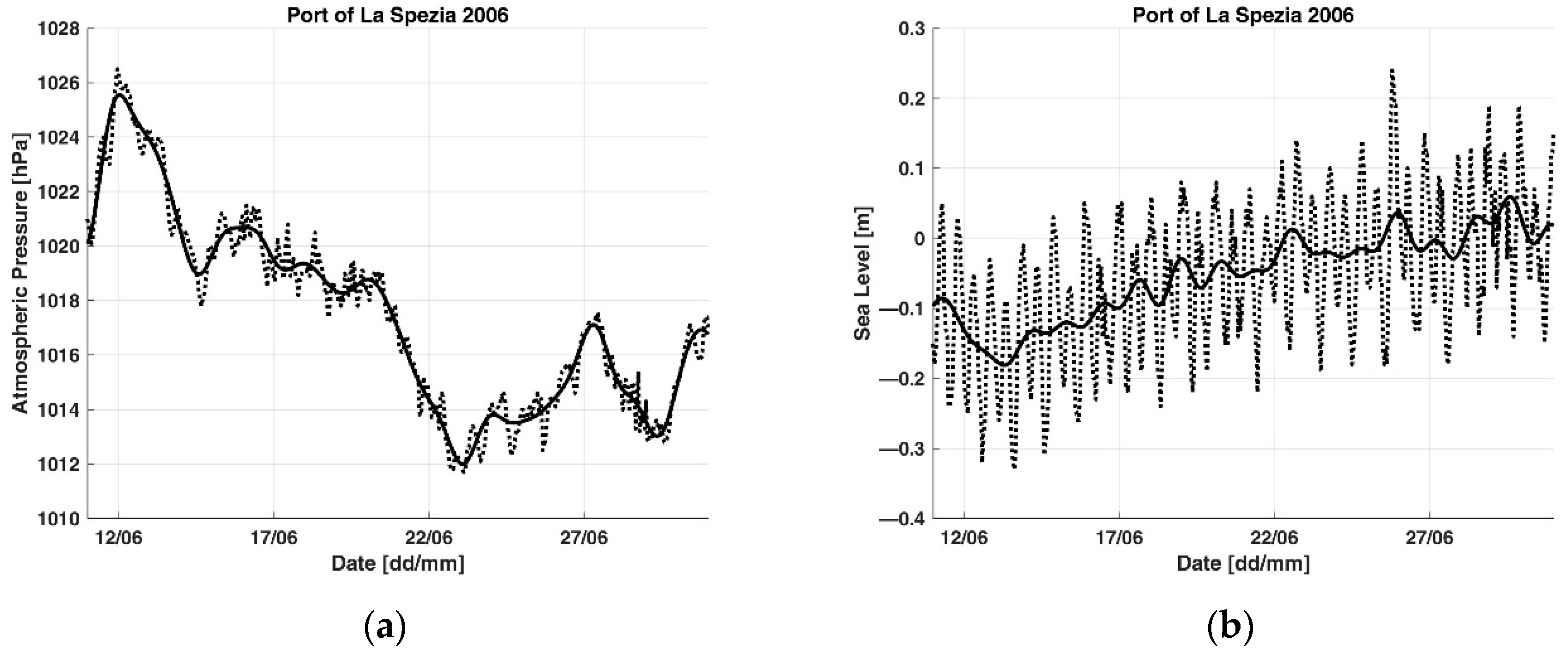
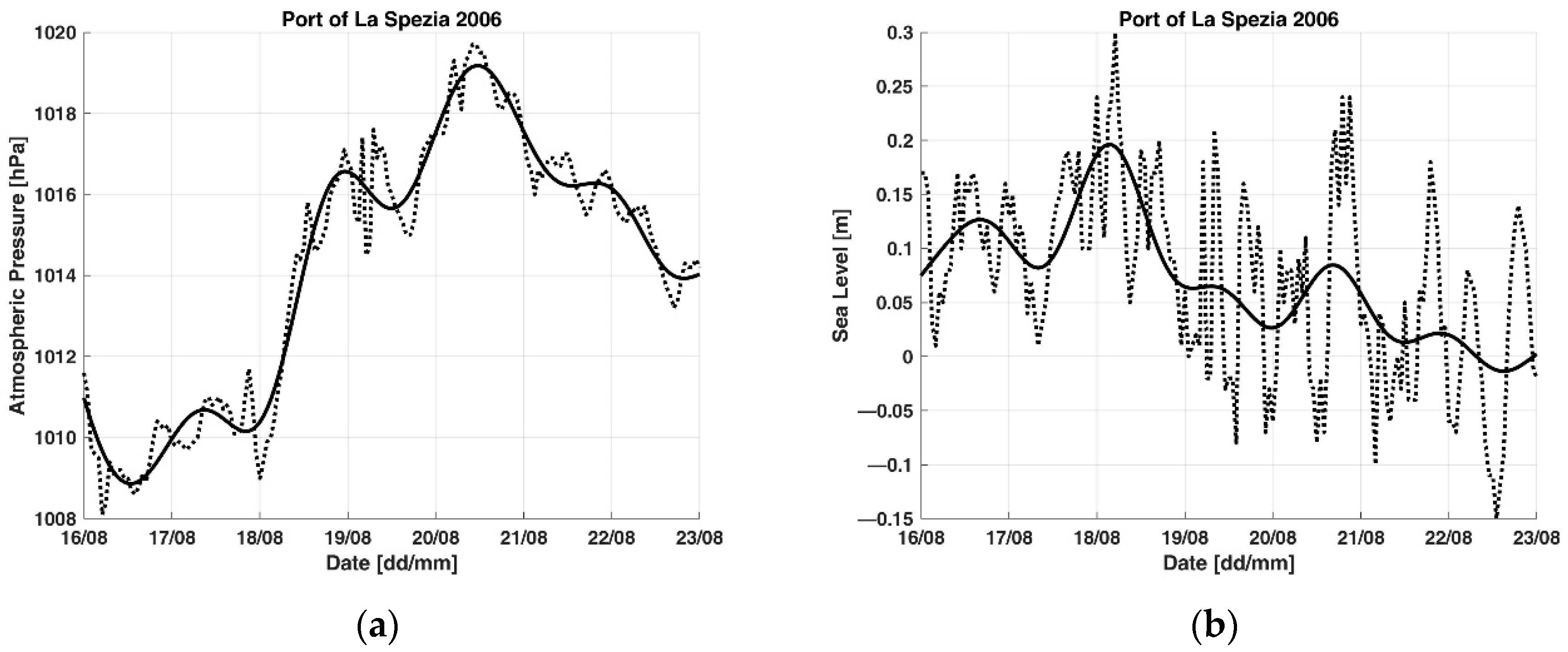
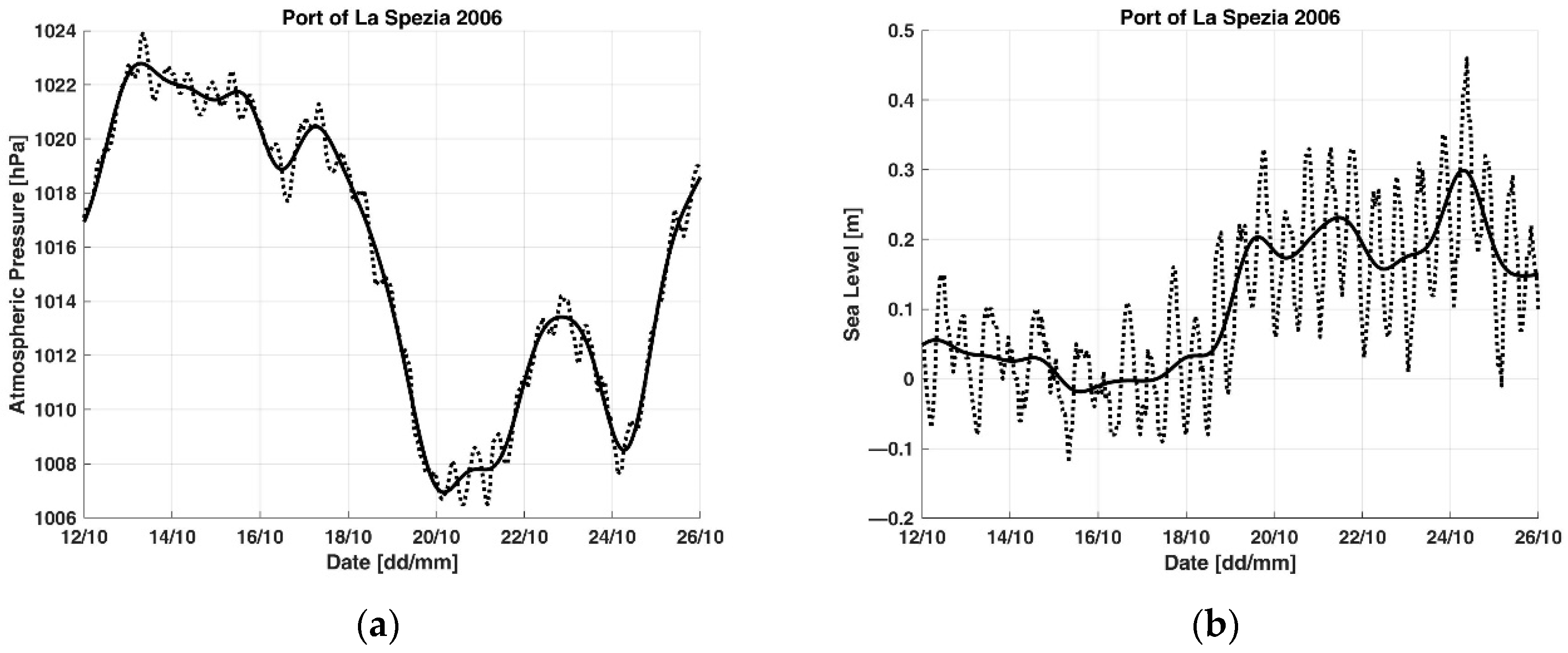

References
- Giuffrida, N.; Stojaković, M.; Twrdy, E.; Ignaccolo, M. The Importance of Environmental Factors in the Planning of Container Terminals: The Case Study of the Port of Augusta. Appl. Sci. 2021, 11, 2153. [Google Scholar] [CrossRef]
- Meyers, S.D.; Luther, M.E. The impact of sea level rise on maritime navigation within a large, channelized estuary. Marit. Pol. Manag. 2020, 47, 920–936. [Google Scholar] [CrossRef]
- Nguyen, T.-H.; Garrè, L.; Amdahl, J.; Leira, B.J. Benchmark study on the assessment of ship damage conditions during stranding. Ships Offshore Struct. 2012, 7, 197–213. [Google Scholar] [CrossRef]
- Ogura, T.; Inoue, T.; Uchihira, N. Prediction of Arrival Time of Vessels Considering Future Weather Conditions. Appl. Sci. 2021, 11, 4410. [Google Scholar] [CrossRef]
- Petraška, A.; Čižiūnienė, K.; Jarašūnienė, A.; Maruschak, P.; Prentkovskis, O. Algorithm for the assessment of heavyweight and oversize cargo transportation routes. J. Bus. Econ. Manag. 2017, 18, 1098–1114. [Google Scholar] [CrossRef] [Green Version]
- Titz, M.A. Port state control versus marine environmental pollution. Marit. Pol. Manag. 1989, 16, 189–211. [Google Scholar] [CrossRef]
- Vandermeulen, J.H. Environmental trends of ports and harbours: Implications for planning and management. Marit. Pol. Manag. 1996, 23, 55–66. [Google Scholar] [CrossRef]
- Istituto Idrografico della Marina. Tavole di Marea 2022; Istituto Idrografico della Marina: Genoa, Italy, 2021.
- Wei, G.; Wang, Q.; Peng, W. Accurate Evaluation of Vertical Tidal Displacement Determined by GPS Kinematic Precise Point Positioning: A Case Study of Hong Kong. Sensors 2019, 19, 2559. [Google Scholar] [CrossRef] [Green Version]
- Allen, J.S.; Denbo, D.W. Statistical Characteristics of the Large-Scale Response of Coastal Sea Level to Atmospheric Forcing. J. Phys. Oceanogr. 1984, 14, 1079–1094. [Google Scholar] [CrossRef]
- Chelton, D.B.; Enfield, D.B. Ocean signals in tide gauge records. J. Geophys. Res. Solid Earth 1986, 91, 9081–9098. [Google Scholar] [CrossRef]
- Dickman, S.R. Theoretical investigation of the oceanic inverted barometer response. J. Geophys. Res. Solid Earth 1988, 93, 14941–14946. [Google Scholar] [CrossRef]
- Dobslaw, H.; Thomas, M. Atmospheric induced oceanic tides from ECMWF forecasts. Geophys. Res. Lett. 2005, 32, L10615. [Google Scholar] [CrossRef]
- Fu, L.-L.; Pihos, G. Determining the response of sea level to atmospheric pressure forcing using TOPEX/POSEIDON data. J. Geosphys. Res. 1994, 99, 24633–24642. [Google Scholar] [CrossRef]
- Moon, I.-J. Impact of a coupled ocean wave-tide-circulation system on coastal modeling. Ocean Model 2005, 8, 203–236. [Google Scholar] [CrossRef]
- Willebrand, J.; Philander, S.G.H.; Pacanowski, R.C. The Oceanic Response to Large-Scale Atmospheric Disturbances. J. Phys. Oceanogr. 1980, 10, 411–429. [Google Scholar] [CrossRef]
- Wunsch, C.; Stammer, D. Atmospheric loading and the oceanic “inverted barometer” effect. Rev. Geophys. 1997, 35, 79–107. [Google Scholar] [CrossRef]
- Dong, D.; Gross, R.S.; Dickey, J.O. Seasonal variations of the Earth’s gravitational field: An analysis of atmospheric pressure, ocean tidal, surface water excitation. Geophys. Res. Lett. 1996, 23, 725–728. [Google Scholar] [CrossRef] [Green Version]
- Faggioni, O.; Arena, G.; Bencivenga, M.; Bianco, G.; Bozzano, R.; Canepa, G.; Lusiani, P.; Nardone, G.; Piangiamore, G.L.; Soldani, M.; et al. The Newtonian approach in meteorological tide waves forecasting: Preliminary observations in the East Ligurian harbours. Ann. Geophys. 2006, 49, 1177–1187. [Google Scholar] [CrossRef]
- Garrett, C.; Majaess, F. Nonisostatic Response of Sea Level to Atmospheric Pressure in the Eastern Mediterranean. J. Phys. Oceanogr. 1984, 14, 656–665. [Google Scholar] [CrossRef]
- Merriam, J.B. Atmospheric pressure and gravity. Geophys. J. Int. 1992, 109, 488–500. [Google Scholar] [CrossRef]
- Spratt, R.S. Modelling the effect of atmospheric pressure variations on gravity. Geophys. J. Int. 1982, 71, 173–186. [Google Scholar] [CrossRef] [Green Version]
- Trenberth, K.E. Seasonal variations in global sea level pressure and the total mass of the atmosphere. J. Geophys. Res. 1981, 86, 5238–5246. [Google Scholar] [CrossRef]
- Bâki Iz, H. The effect of regional sea level atmospheric pressure on sea level variations at globally distributed tide gauge stations with long records. J. Geod. Sci. 2018, 8, 55–71. [Google Scholar] [CrossRef] [Green Version]
- Crépon, M. Influence de la pression atmosphérique sur le niveau moyen de la Méditerranée Occidentale et sur le flux à travers le détroit de Gibraltar. Cah. Oceanogr. 1965, 1, 15–32. [Google Scholar]
- Deser, C.; Tomas, R.A.; Sun, L. The Role of Ocean-Atmosphere Coupling in the Zonal-Mean Atmospheric Response to Arctic Sea Ice Loss. J. Clim. 2015, 28, 2168–2186. [Google Scholar] [CrossRef] [Green Version]
- Garrett, C.; Toulany, B. Sea level variability due to meteorological forcing in the northeast Gulf of St. Lawrence. J. Geophys. Res. 1982, 87, 1968–1978. [Google Scholar] [CrossRef]
- Le Traon, P.-Y.; Gauzelin, P. Response of the Mediterranean mean sea level to atmospheric pressure forcing. J. Geophys. Res. 1997, 102, 973–984. [Google Scholar] [CrossRef] [Green Version]
- Ponte, R.M.; Gaspar, P. Regional analysis of the inverted barometer effect over the global ocean using TOPEX/POSEIDON data and model results. J. Geosphys. Res. 1999, 104, 15587–15601. [Google Scholar] [CrossRef]
- Tsimplis, M.N. The Response of Sea Level to Atmospheric Forcing in the Mediterranean. J. Coast. Res. 1995, 11, 1309–1321. [Google Scholar]
- Tsimplis, M.N.; Vlahakis, G.N. Meteorological forcing and sea level variability in the Aegean Sea. J. Geophys. Res. 1994, 99, 9879–9890. [Google Scholar] [CrossRef]
- Faggioni, O.; Soldani, M. Geomatics for underwater electromagnetic harbour protection systems and Newtonian systems for coastal navigation safety—Theory. In Proceedings of the Giornate INGV sull’Ambiente Marino—INGV Workshop on Marine Environment, Rome, Italy, 26–27 June 2019; Abstract Volume. Miscellanea INGV. Sagnotti, L., Beranzoli, L., Caruso, C., Guardato, S., Simoncelli, S., Eds.; Istituto Nazionale di Geofisica e Vulcanologia: Rome, Italy, 2019; Volume 51, pp. 111–114. [Google Scholar] [CrossRef]
- Faggioni, O.; Soldani, M.; Piangiamore, G.L.; Ferrante, A.; Bencivenga, M.; Arena, G.; Nardone, G. harbour Water Management for port structures and sea bottom design, coast proximity navigation management, water quality control. In Proceedings of the 1st Mediterranean Days of Coastal and Port Engineering, Palermo, Italy, 7–9 October 2008; PIANC: Brussels, Belgium, 2008. [Google Scholar]
- Soldani, M. Geomatics for Port Safety and Security. In R3 in Geomatics: Research, Results and Review. Communications in Computer and Information Science; Parente, C., Troisi, S., Vettore, A., Eds.; Springer: Cham, Switzerland, 2020; Volume 1246, pp. 91–102. [Google Scholar] [CrossRef]
- Soldani, M. The contribution of Geomatics to increase safety and security in ports. Appl. Geomat. 2021, 12. [Google Scholar] [CrossRef]
- Soldani, M.; Faggioni, O. Geomatics for underwater electromagnetic harbour protection systems and Newtonian systems for coastal navigation safety—Applications. In Proceedings of the Giornate INGV sull’Ambiente Marino—INGV Workshop on Marine Environment, Rome, Italy, 26–27 June 2019; Abstract Volume. Miscellanea INGV. Sagnotti, L., Beranzoli, L., Caruso, C., Guardato, S., Simoncelli, S., Eds.; Istituto Nazionale di Geofisica e Vulcanologia: Rome, Italy, 2019; Volume 51, pp. 115–118. [Google Scholar] [CrossRef]
- Soldani, M.; Faggioni, O. A System to Improve Port Navigation Safety and Its Use in Italian harbours. Appl. Sci. 2021, 11, 10265. [Google Scholar] [CrossRef]
- Soldani, M.; Faggioni, O. A tool to aid the navigation in La Spezia harbour (Italy). In Geomatics for Green and Digital Transition; ASITA2022; Communications in Computer and Information Science; Borgogno-Mondino, E., Zamperlin, P., Eds.; Springer: Cham, Switzerland, 2022; Volume 1651, pp. 89–101. [Google Scholar] [CrossRef]
- Faggioni, O. The Information Protection in Automatic Reconstruction of Not Continuous Geophysical Data Series. J. Data Anal. Inform. Process. 2019, 7, 208–227. [Google Scholar] [CrossRef] [Green Version]
- Faggioni, O. Measurement and Forecasting of Port Tide Hydrostatic Component in North Tyrrhenian Sea (Italy). Open J. Mar. Sci. 2020, 10, 52–77. [Google Scholar] [CrossRef]
- Faggioni, O.; Soldani, M.; Leoncini, D.A. Metrological Analysis of Geopotential Gravity Field for Harbor Waterside Management and Water Quality Control. Int. J. Geophys. 2013, 2013, 398956. [Google Scholar] [CrossRef]
- Kanasewich, E.R. Time Sequence Analysis in Geophysics, 3rd ed.; The University of Alberta Press: Edmonton, AB, Canada, 1981. [Google Scholar]
- Krishnamurti, T.N. Numerical Weather Prediction. Annu. Rev. Fluid Mech. 1995, 27, 195–224. [Google Scholar] [CrossRef]
- Lynch, P. The origins of computer weather prediction and climate modeling. J. Comp. Phys. 2008, 227, 3431–3444. [Google Scholar] [CrossRef] [Green Version]
- Telford, W.M.; Geldart, L.P.; Sheriff, R.E. Applied Geophysics, 2nd ed.; Cambridge University Press: Cambridge, UK, 1990. [Google Scholar] [CrossRef]
- Cabos, W.; de la Vara, A.; Álvarez-García, F.J.; Sánchez, E.; Sieck, K.; Pérez-Sanz, J.-I.; Limareva, N.; Sein, D.V. Impact of ocean-atmosphere coupling on regional climate: The Iberian Peninsula case. Clim. Dyn. 2020, 54, 4441–4467. [Google Scholar] [CrossRef]
- El-Gindy, A.A.H.; Eid, F.M. Long-term variations of monthly mean sea level and its relation to atmospheric pressure in the Mediterranean Sea. Int. Hydrogr. Rev. 1990, 67, 147–159. [Google Scholar]
- Bartlett, D.; Celliers, L. (Eds.) Geoinformatics for Marine and Coastal Management, 1st ed.; CRC Press: Boca Raton, FL, USA, 2016. [Google Scholar] [CrossRef]
- Lam, S.Y.-W.; Yip, T.L. The role of geomatics engineering in establishing the marine information system for maritime management. Marit. Pol. Manag. 2008, 35, 53–60. [Google Scholar] [CrossRef]
- Palikaris, A.; Mavraeidopoulos, A.K. Electronic Navigational Charts: International Standards and Map Projections. J. Mar. Sci. Eng. 2020, 8, 248. [Google Scholar] [CrossRef] [Green Version]
- Weintrit, A. Geoinformatics in Shipping and Marine Transport. In Challenge of Transport Telematics: TST 2016. Communications in Computer and Information Science; Mikulski, J., Ed.; Springer: Cham, Switzerland, 2016; Volume 640, pp. 13–25. [Google Scholar] [CrossRef]
- Bąk, A.; Zalewski, P. Determination of the Waterway Parameters as a Component of Safety Management System. Appl. Sci. 2021, 11, 4456. [Google Scholar] [CrossRef]
- Ducruet, C.; Berli, J.; Bunel, M. Geography versus topology in the evolution of the global container shipping network (1977–2016). In Geographies of Maritime Transport: Transport, Mobilities and Spatial Change; Wilmsmeier, G., Monios, J., Eds.; Edward Elgar Publishing: Cheltenham, UK, 2020; pp. 49–70. [Google Scholar] [CrossRef]
- Nohheman, W. Benefits of dredging through reduced tidal waiting. Marit. Pol. Manag. 1981, 8, 17–20. [Google Scholar] [CrossRef]
- Vidmar, P.; Perkovič, M.; Gucma, L.; Łazuga, K. Risk Assessment of Moored and Passing Ships. Appl. Sci. 2020, 10, 6825. [Google Scholar] [CrossRef]


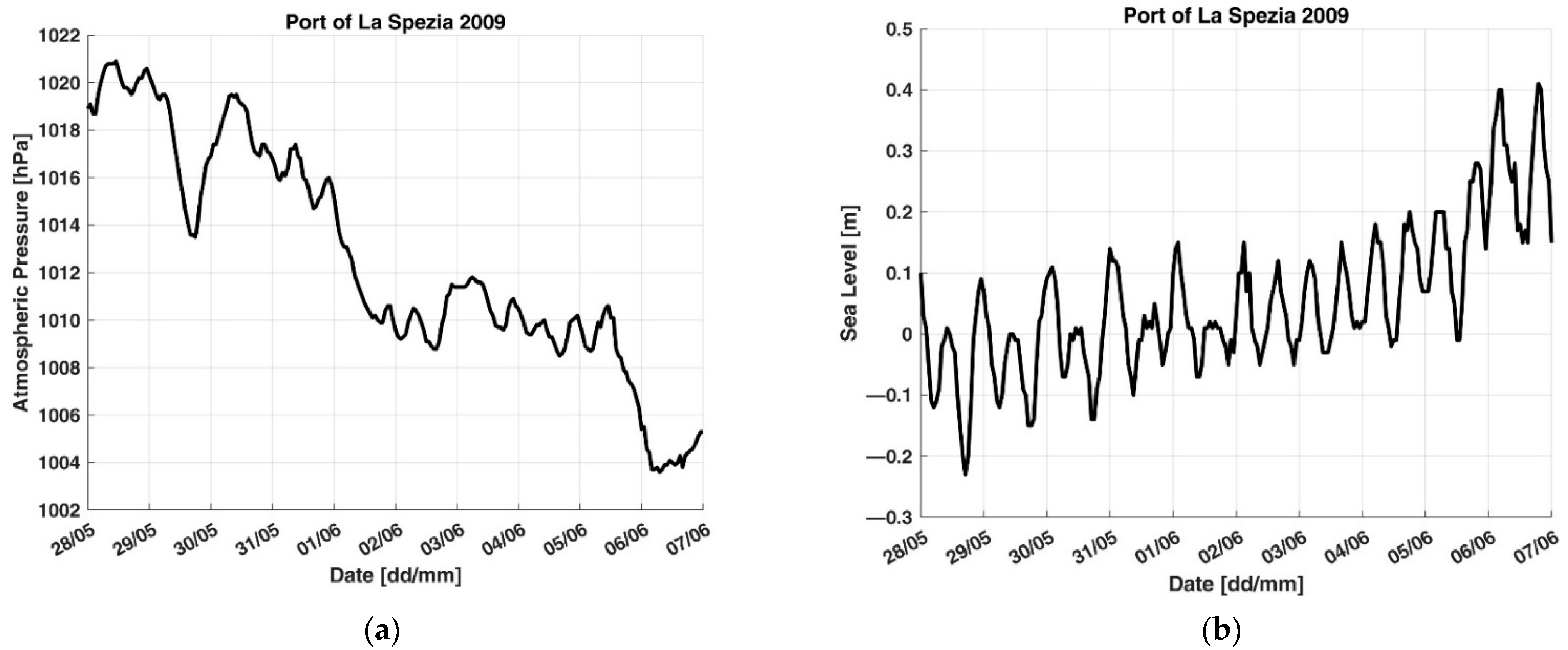
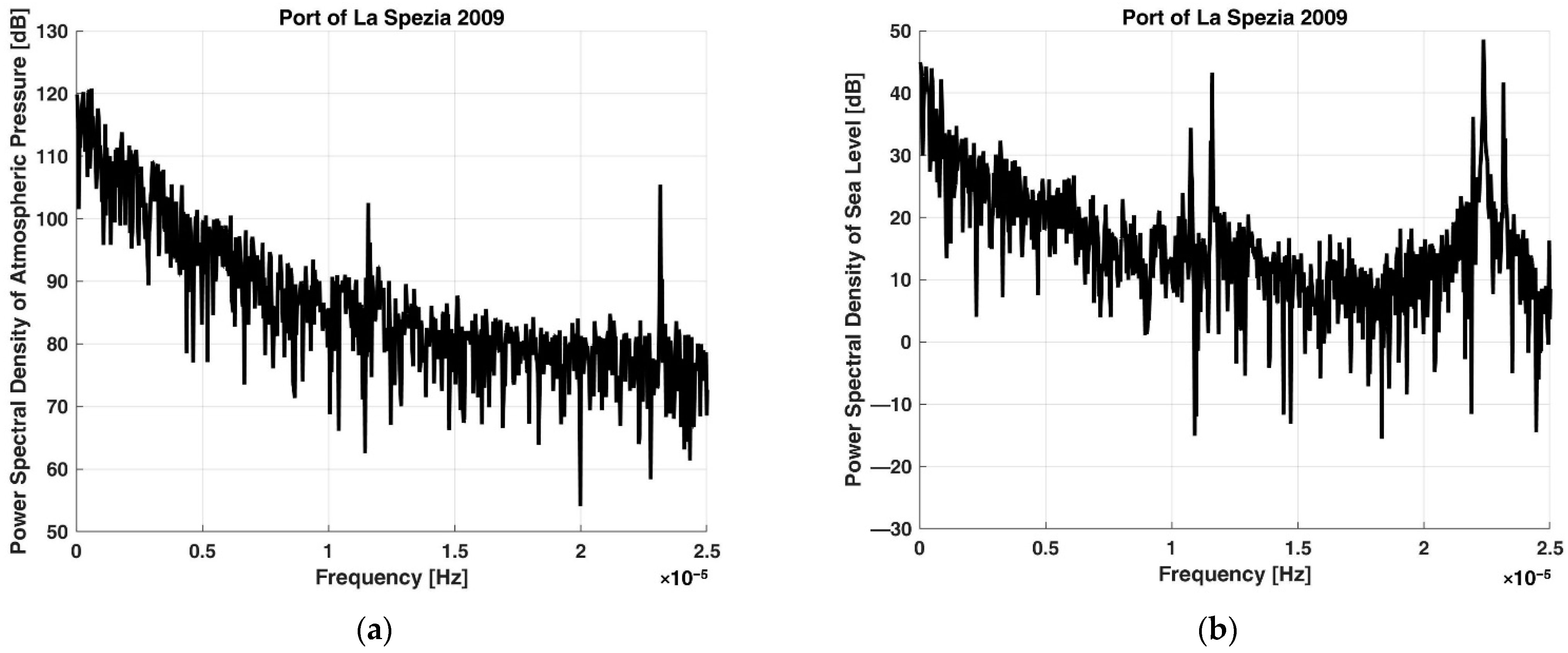
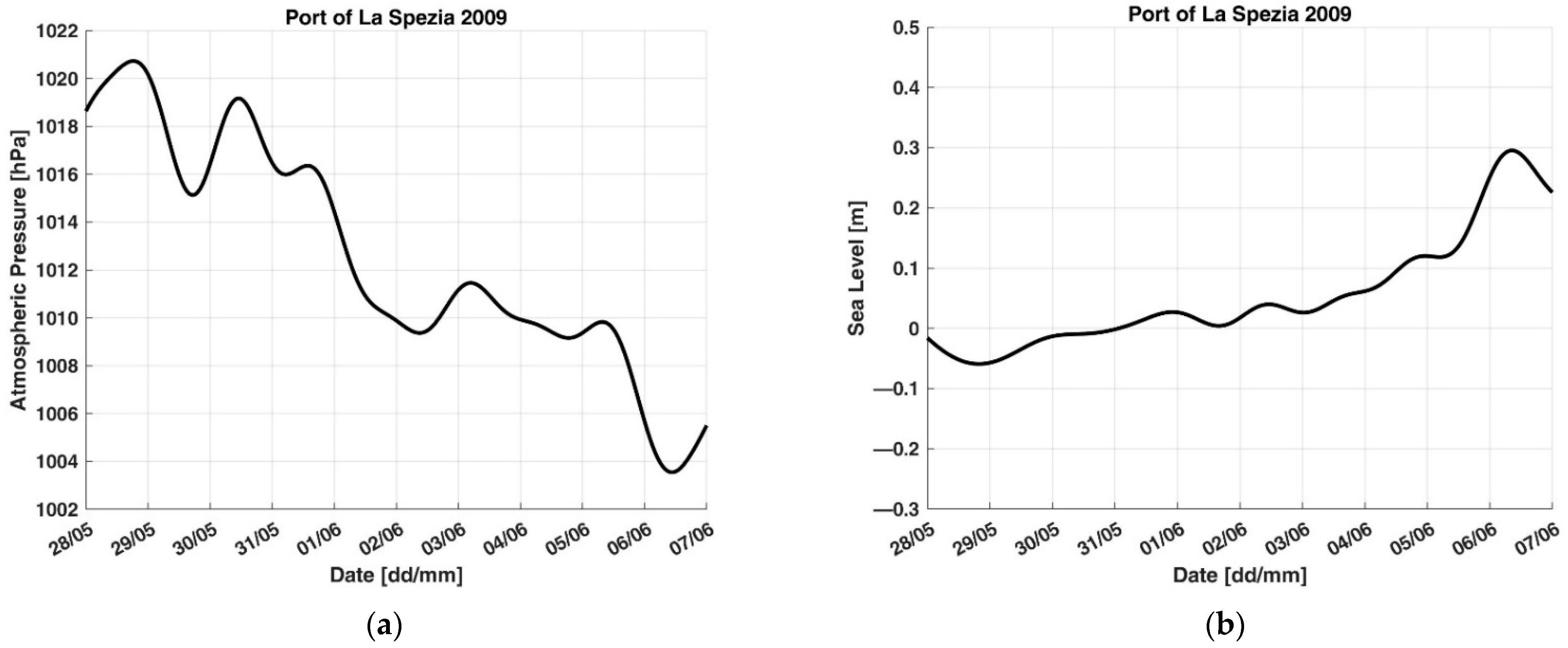


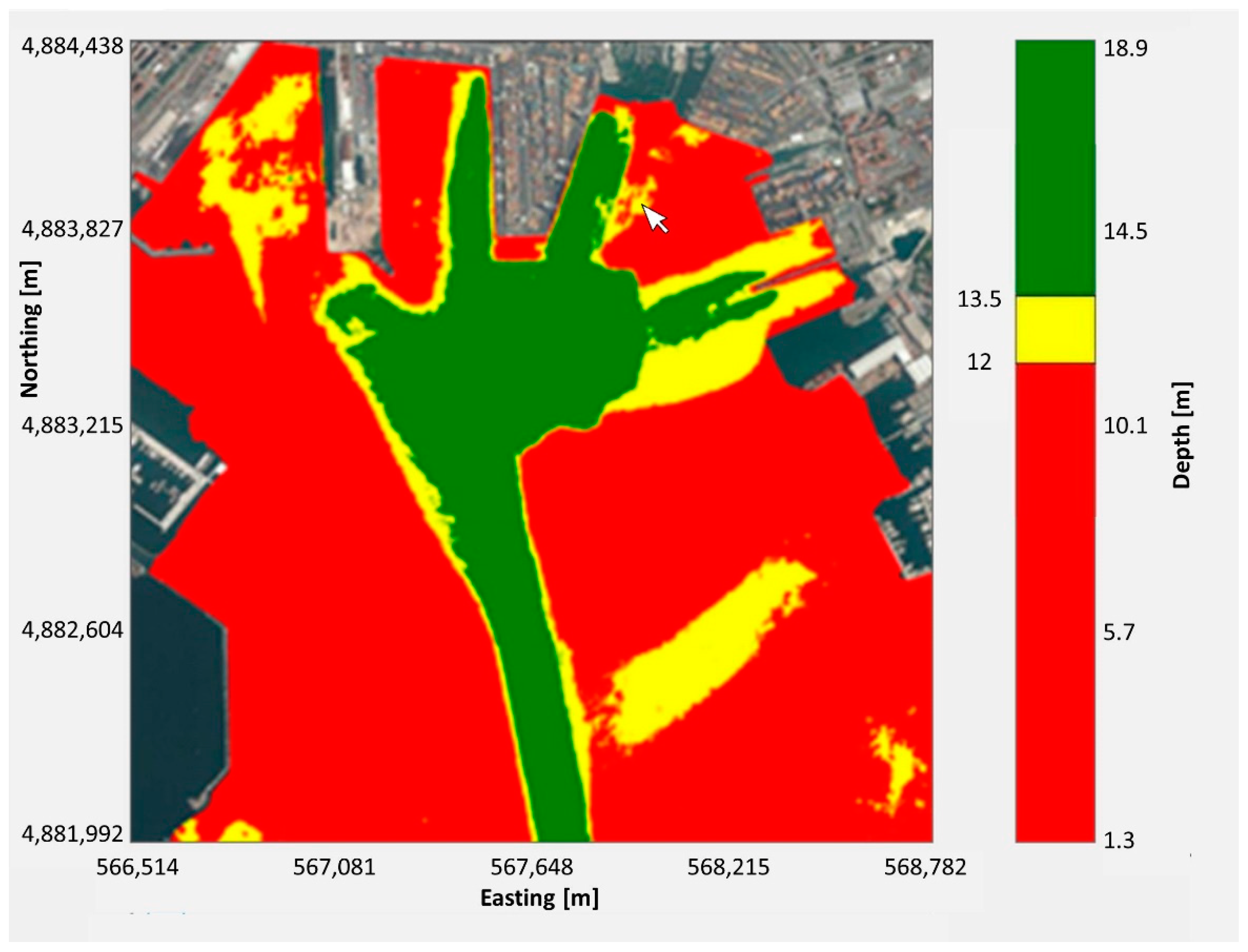
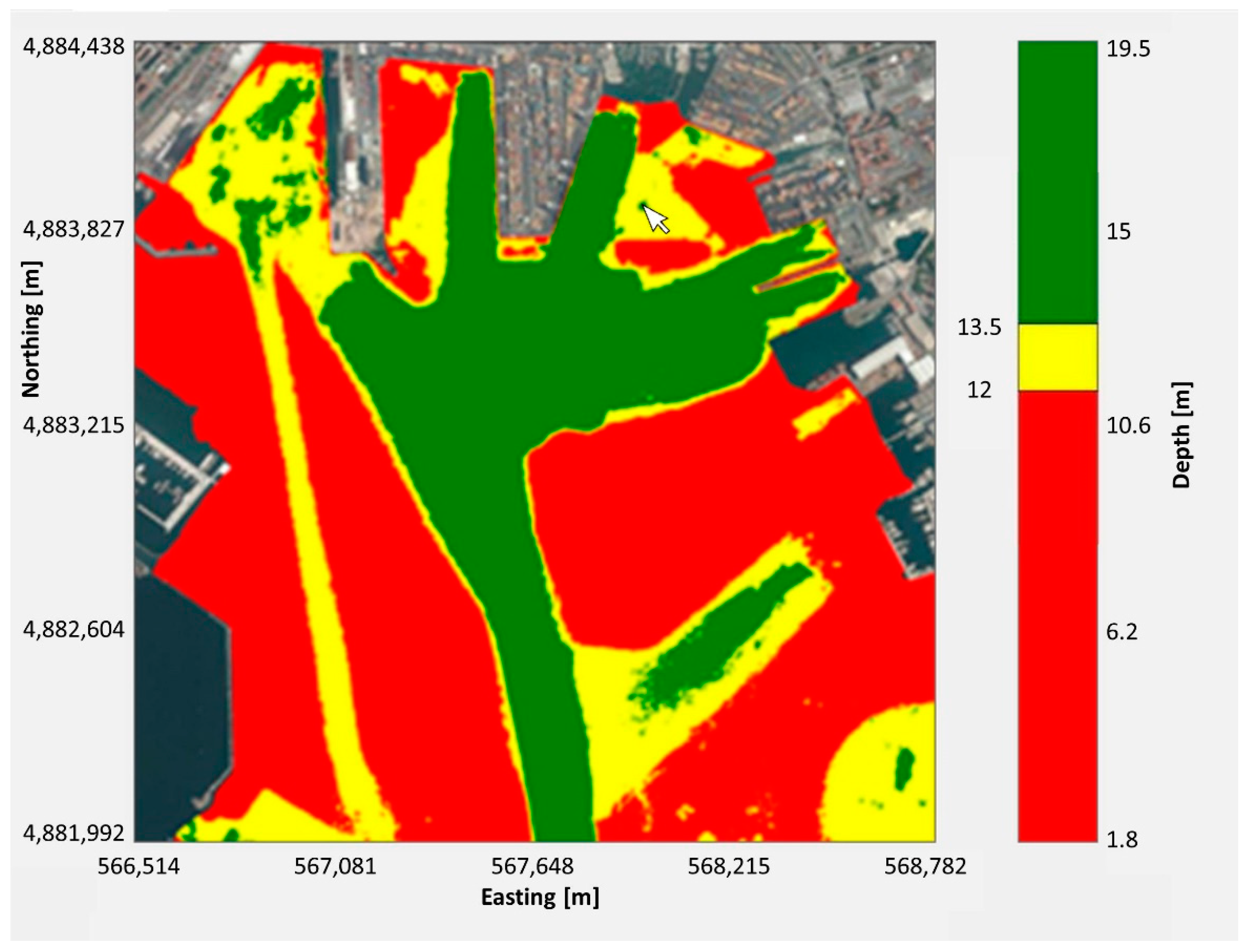

| Name | Harmonic Constituent | Period/h |
|---|---|---|
| M2 | Principal lunar semi-diurnal | 12.4206 |
| S2 | Principal solar semi-diurnal | 12.0000 |
| N2 | Larger lunar elliptic semi-diurnal | 12.6583 |
| K2 | Luni-solar declinational semi-diurnal | 11.9672 |
| K1 | Luni-solar declinational diurnal | 23.9345 |
| O1 | Principal lunar declinational diurnal | 25.8193 |
| P1 | Principal solar declinational diurnal | 24.0659 |
| Q1 | Lunar flowelliptic diurnal | 26.8680 |
Publisher’s Note: MDPI stays neutral with regard to jurisdictional claims in published maps and institutional affiliations. |
© 2022 by the authors. Licensee MDPI, Basel, Switzerland. This article is an open access article distributed under the terms and conditions of the Creative Commons Attribution (CC BY) license (https://creativecommons.org/licenses/by/4.0/).
Share and Cite
Soldani, M.; Faggioni, O. Observing Meteorological Tides: Fifteen Years of Statistics in the Port of La Spezia (Italy). Appl. Sci. 2022, 12, 12202. https://doi.org/10.3390/app122312202
Soldani M, Faggioni O. Observing Meteorological Tides: Fifteen Years of Statistics in the Port of La Spezia (Italy). Applied Sciences. 2022; 12(23):12202. https://doi.org/10.3390/app122312202
Chicago/Turabian StyleSoldani, Maurizio, and Osvaldo Faggioni. 2022. "Observing Meteorological Tides: Fifteen Years of Statistics in the Port of La Spezia (Italy)" Applied Sciences 12, no. 23: 12202. https://doi.org/10.3390/app122312202






